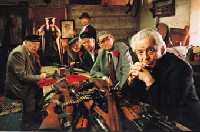A rather common myth holds that the Croats are masters of the marginal arts. In Croatian literature, for example, there are just a few exceptional novelists and playwrights, but many great poets. The tradition of Croatian art in the twentieth century is rich in experimental music, abstract and constructivist painting, sculpture and many other disciplines involving small tribes of educated intellectual insiders. But Croatia's modern cultural history, with few exceptions, seriously lacks populist impulses.
Croatian film has had a similar destiny. Where Croatia has succeeded most is not with the "ordinary" feature film, as during the four post-World War II decades, but, rather, Croatia is known to be a strong source of experimental and alternative cinema and, more specifically, an animated film super power.
Keeping up with the cartoonsThe so-called Zagreb cartoon school, which reached its peak between 1957 and 1968, is widely considered one of the most important modernist European animated film schools, and Zagreb director Dušan Vukotić (1927-98) was the first European to win an Oscar for film animation for his 1961 film Surogat (The Subsitute). A retrospective at this year's Annecy Film Festival showcased nine Croatian films, which rank among the 50 most important classics of world animation.
Croatian feature films, however, could not compete with their animated counterparts' international relevance, although national cinema has had some international successes, of course. Three Croatian films have managed Oscar nominations but, paradoxically, all three were directed by non-Croatians: Italian Giuseppe De Santis for Cesta duga godinu dana (A Road One Year Long, 1958), Slovenian France Štiglic for Deveti krug (Ninth Circle, 1960) and Montenegrin Veljko Bulajić for Bitka na Neretvi (Battle on the River Neretva, 1969).
In particular, the Croatian feature film industry has been considered less successful than its Serbian counterpart. Particularly after the so-called "Black Wave" of the late sixties, Serbian film became, politically, extremely provocative and non-conformist. Serbia had, and still has, a strong populist film tradition that includes many commercially successful low-budget and low-quality comedies. By contrast, Croatian film has shared the general character of its national culture: it has been hermetic, intellectual, structurally and formally complex and splendidly isolated from its own audience.
There are two significant exceptions. The first was Krešo Golik (1922-1998), the extremely popular director of comedies like Plavi 9 (Blue 9, 1950) and Tko pjeva zlo ne misli (He Who Sings Never Means Harm, 1970), while the other is Branko Bauer (b 1921), a great master of thrillers, war dramas and adventure films targeted to younger audience, a classic narrative master in Hollywood terms. Besides these two filmmakers, all other Croatian classics were intellectual film directors with a capital "D": the Catholic existentialist Branko Babaja, the ironic liberal Zvonimir Berković, the grotesque and bombastic Lordan Zafranović and the rigid modernist Vatroslav Mimica, among others.
Crisis in Croatian cinemaThe fall of Communism and the beginning of Franjo Tuđman's semi-dictatorship in 1990 caused an enormous crisis in Croatian cinema. The nineties are commonly considered the worst period in Croatian film production since World War II.
The first reason for such a crisis was typical of all countries in post-Communist transition. All Eastern European cinemas - including the most famous, Hungarian and Czech - suffered from the shock of transition in the early 1990s, as state subsidies suddenly evaporated and directors lost the regime and totalitarianism as topics and targets.
They were also forced to compete with the Western film industry on the film market and suddenly realised that there was no longer public interest in, or a market for, their work. Some of the Eastern cinemas, particularly the Polish and Czech, have survived the transition, while others, such as the Russian film industry, have not.
The Croatian crisis was even deeper, because of the strong director-orientated nature of national cinema. The late 1980s were generally a period of crisis for the old-fashioned European auteur film, as a postmodernist mentality and Hollywood's economic boom shifted filmmakers' interests toward narration, genre films and an ironic twist on popular-culture traditions. Old, boring and exclusive European authors seemed like dinosaurs, and Croatian cinema basically bred that kind of film.
A third reason for the extreme depth of the crisis was generational, as old classic directors stopped directing in 1990s, with one or two exceptions. The forty-something generation had only one important director, Rajko Grlić (b 1947), but he left Croatia to teach film in the United States.
This generation gap is typical of Croatian culture in general. The baby-boomer generation raised in the era of relative wealth during the golden era of Tito's regime (the 1960s and 1970s) strongly influences Croatian media, politics and economy today, but it is practically non-existent in Croatian cinema, literature and theatre. Well educated, liberally raised and materialist, the now fifty-something generation chose more lucrative areas of creativity, such as journalism, design and architecture.
The final and most important cause of the crisis in Croatian film was the political context in which it found itself during the first post-Communist decade. Anti-modern, historicist and logocentric, Tuđman's regime did not care much for cinema. Perhaps the most important factor behind the golden age of Yugoslav cinema was the fact that Tito was a film fan who regularly attended the national film festival in Pula and who, as legend holds, always kept a couple of reels of American Westerns in the cellar projection room of his villa.
By contrast, the object of Tuđman's fanaticism was not cinema, but football. He poured enormous sums of money into his favorite toy, FC Croatia Zagreb, and his scandalous obsession with football reached the height of its silliness when the media revealed that the secret services were fixing match results in favor of Tuđman's favourite club. At the same time, Tito's favorite pastime - cinema - seemed abandoned and poor, as the main fields of interest in national cultural politics were historical heritage, archeology and language.
The Tuđman regime used film primarily as a propaganda tool. Tito's regime did, too, but the difference was that Tito's Communist propaganda machine imposed a basic level of quality and required certain skills and craftsmanship from directors. Some of these directors, such as Bosnian Hajrudin Krvavac or Serbian Žika Mitrović, were real masters of their art. Since Tuđman's regime was quite uninterested in film, the making of propaganda war films became a discipline for professional losers, directors with strong political backgrounds and zero skills.
An example of this kind is Jakov Sedlar, Tuđman's favorite director. This former water polo player and documentarist contributed to the regime with two especially notorious films: Gospa (Madonna, 1995), about a miracle taking place in the town of Međugorje, and Četverored (In Four Rows, 1999), a film about the 1945 Communist massacre of exiled soldiers and civilians at Bleiburg field in Austria. The film, finished in autumn 1999, was used by the then-ruling Croatian Democratic Community (HDZ) to try to increase anti-Communist hysteria during the election campaign, which brought about the defeat of Tuđman's party.
Sedlar, though, was just one of many. Numerous war films full of hatred and political propaganda and of low professional quality turned audiences against Croatian cinema in general. During the worst period of the 1991-1995 war, bootleg videos of Serbian films were quite popular among citizens of Croatian cities. Still distributed regularly, Serbian films have continued to draw audiences. Simultaneously, Croatian film fans generally detest Croatian films.
A handful of propaganda mercenaries have poisoned the water, and the whole Croatian film industry has lost its audience - which is a pity, because a new generation of filmmakers emerged in the 1990s, promising a new future for Croatian cinema.
Trying to restore the fameThis new generation appeared self-consciously in 1993, calling itself Young Croatian Film (YCF), and, in a few short years, the Zagreb film academy produced 10 to 15 promising student films and several gifted directors.
YCF was not welcomed by the authorities of the day. Directors of the so-called "war generation," born between 1965 and 1973, were making documentaries and feature-films about war, but they were quite different from the "official" form. The new genre was bleak, pessimistic and tragic and included Ivan Salaj's Vidimo se (See You, 1995), a kind of John Milius war film, whose lead character was a member of the radical Party of Right's militia, HOS. Goran Višnjić, then anonymous but now Croatia's most famous film star, held the lead role - and he is now starring in the popular American TV show ER, where he replaced George Clooney.
Warmly acclaimed by critics, YCF has not given what might be expected from the talent of the directors it encompassed. Ivan Salaj has never made another film, and another gifted director of this generation, Jelena Rajković, died in 1997. Other members of YCF either disappeared or continued with long-features, which were not as good as their early short films and made-for-television films.
 |
| Comedy of War |
Vinko Brešan (b 1964), is a director of popular comedies in the tradition of Krešo Golik. After several prize-winning documentaries, Brešan made Kako je počeo rat na mom otoku (How the War on My Island Started, 1996), a black war comedy, which became the greatest hit of contemporary Croatian film, as more than 300,000 in Croatia flocked to see it.
 |
| Best of the 1990s |
Brešan's films have also had some international success. His first offering won the main prize at the 1997 Cottbus Film Festival, while Maršal played at this year's Berlin Film Festival and won the special prize for Junge Filme selection.
 |
| Mondo Bobo : Slick gangster flick |
The most internationally successful Croatian director at this moment, though, is Zrinko Ogresta (b 1958). Although he was a strong supporter of Tuđman's regime, he became famous - paradoxically - due to his bleak and pessimistic social dramas Isprani (Washed Out, 1995), winner of the Prix Italia, and Crvena prašina (Red Dust, 1999), a winner at the Haifa Film Festival. The second one, which was also screened at the Venice Film Festival, deals with tajkunizacija (tycooning), repossession and the destruction of national industry by mobster-businessmen supported by national political structures.
In the late 1990s, using industry factories as a source and mortgage for unrealistic bank credits, politically protected tycoons sucked national coffers dry, causing the collapse of the nation's banking system and an absurd increase in unemployment to 25 percent. Victims of this process were industry workers and the suburban population, the people who had contributed most to the war effort and who were pillars of Tuđman's strength and popularity.
By the late 1990s, the social crisis had reached its peak and, at the end of Crvena prašina, when police shoot the brick factory worker-rebel and war hero, Croatian film finally opened its eyes to the increasing social, economic and moral crisis of the decaying Tuđman regime. Brutal reality - tycooning, unemployment, corruption, connections between politics and crime, suicides of disappointed war vets - was systematically expelled from Croatian film in the 1990s, but it could not be expelled entirely.
The Croatian film industry looks at the post-Tuđman era with the same mixture of optimism and fear as Croatian society in general. In particular, the industry expects a lot from the new government and the Ministry of Culture, which is traditionally short of money.
Outlook: fairThere are reasons for optimism, however. Members of early-1990s Young Croatian Film movement, together with newcomers, constitute an interesting group of ten to 12 young directors. In 1998 and 1999, Croatian films won more international prizes and appreciation than in the whole previous decade. Directors are no longer faced with political obstacles, for the whole system of subtle prohibition and censorship, which sterilized Croatian cinema in the 1990s, but never resorted to outright bans, disappeared after the fall of the HDZ.
Changes are particularly expected in national television, because Croatian Television (HTV) is the main producer of feature films in Croatia, and, during the Tuđman era, television production was under greater political pressure than the rest of the national cinema.
The problems of the Croatian film industry are still dramatic. The main national producer and the only big studio, Jadran Film (JF), was a victim of tajkunizacija. It is now under the partial control of some fishy business people from the Tuđman era, has fallen behind the pace of technological changes and lost numerous co-production jobs, which were what had made the company very profitable in 1970s and 1980s.
JF itself was victim of the general Croatian political position: in the mid 1990s, for example, Steven Spielberg forbade his producers to sign a contract with JF to help produce for Schindler's List, because of Tuđman's refusal to cooperate with the International Criminal Tribunal in the Hague. The production was completed in Poland and Slovakia instead.
The rest of the system is ill, too. Cinemas almost disappeared during the war, as a result of tajkunizacija. Croatia now has fewer than 30 cinemas per one million inhabitants, while in the mid-1990s the Czech Republic had more then 150 for the same number. Furthermore, the biggest national distributor and cinema-owner, Kinematografi Zagreb, which sells about 50 percent of tickets in Croatia, was recently and mysteriously sold to an off-shore company, an international real estate fund based in London. Many professionals now fear the closing down of their cinemas.
The only good news in this sector was the opening of the first national multiplex cinema in Zagreb this March, a joint venture between Croatian and Hungarian investors.
National production in the 1990s amounted to four to six long feature films per year. Given the population of Croatia, its economic circumstances and the war, that is not that bad. But, half of production was reserved for politically motivated propaganda projects, during the HDZ era, so there was little room for real filmmakers. The situation is even worse when we consider that there were no institutional subsidies for documentaries and experimental films at that time, and that the animated film industry suffered from an even bitterer crisis.
Furthermore, the cost of production in Croatia has increased because of tax policies. There are no tax deductions for Croatians sponsoring culture, and cinema tickets and production investments are not free of the enormously high value-added tax (PDV) of 22 percent.
Some things are slowly changing with the new government, however. Once again, there are subsidies for short and documentary films, while the new authorities have announced that cinema tickets, books and film production will be tax exempt as a part of the tax reform for 2001. The Minister of Culture is considering the re-internationalization of the annual Pula Film Festival, which is held at the old Roman circus maximus in Pula during the last week of July. Pula was the most important festival for former-Yugoslav cinema, but it suffered from an identity crisis trying to survive as a national festival during 1990s. Its future concept is still under discussion.
Some independent initiatives may also now expect more help from the state. These include two independent international festivals: one in the historic city of Motovun, in Istria, organized by Rajko Grlić, and a Festival of New Film and Video which will take place in Split every October. The latter, founded in 1996, specializes in experimental film, video and multimedia art and is quite an original concept. These festivals, together with the independent documentary production company Factum and the international summer film school, Imaginary Academy, in Grožnjan (Istria), were shelters and a kind of film resistance movement during Tuđman's time. Now, they will become part of official cinema politics.
The most important change in Croatian cinema should be the founding of a national film board (or institute), which is set for this autumn. Croatia is one of a few European countries with its cinema under the direct control of the government, ie a film committee (povjerenstvo) appointed by the Minister. Under the Tuđman regime, the Directors' Guild and the opposition had consistently asked for a more liberal, modern and less politically influenced way of governing cinema. In 2001, Croatian cinema will be granted a non-governmental board to deal with subsidies, film archives, education, film publishing and international sales.
The current situation in European film indicates that the most vivid and influential productions and directors come from the edge, from small cultures like Finland (the Kaurismaki brothers), Denmark (Lars Von Trier and Nicolas W Refn and Thomas Winterberg), Belgium (the Dardaene brothers and Van Dormael) and the Czech Republic (Saša Gedeon, Petr Zelenka and Jan Svěrák). That is a promising situation for any small culture like Croatia.
Of course, no political changes or changes in film policy can guarantee that Croatia will produce someone like Almodovar or von Trier in the near future, but these changes and a dozen prospective young directors guarantee that Croatian cinema will never again be an object of the mockery of local film fans.
Jurica Pavičić, 15 May 2000
Also of interest:
- Young Croatian Cinema by Ivo Škrabalo
- Avant-garde Film and Video in Croatia by Andrew James Horton
- Resources on Croatian cinema in the Kinoeye archive
Moving on:



